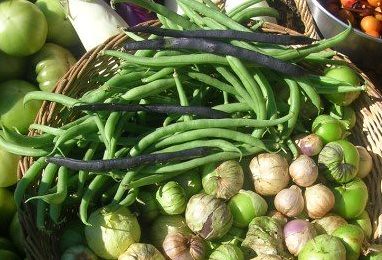How to Grow More than “Green” Beans (Other Colors of Snap Beans)
If ordinary snap beans are getting boring, it’s time to try purple or yellow ones! Many people are hesitant to try unusual vegetables but let me offer reassurance that they’re just as easy and tasty as the green versions. In fact, they are so similar that you can mix and match what you grow and use a potpourri in the same recipes.
Additionally, there is little difference between flat, thin, or curled snap beans — at least no more contrast than you would expect from different varieties of tomatoes or squash. Some may have superior flavor, tenderness, growth habits, disease resistance, or productivity. Other than that you can treat them as the same animal.
The most important feature to look for when purchasing snap bean seed is whether you are getting a pole or bush type. This makes a difference in where you can grow them in your garden but the beans you pick from the plants will be similar.
Up until last year I lived in an extremely sunny yard with limited space. I couldn’t imagine why anyone would bother growing bush beans because I found pole beans so useful in intensive space gardening. I could grow more food upright on trellises than I could low to the ground. Now that I have moved to a yard with part sun and limited space, I’ve found the shrubby habit of bush beans highly useful. I am concerned about my crops shading each other, so it is nice to fill in the gaps between tall plants with a block of short bush beans.
Beans are also beneficial to the soil. I amended my new beds with compost but the soil isn’t as nice as my previous garden where I had been adding compost for 8 years. Beans fix nitrogen to their roots and after the harvest they release it into the soil along with organic matter as they decay. They act as a dual purpose cover crop — food and soil improvement at the same time!
Though I occasionally find an inedible tough and swollen pod that I missed when picking over my green beans, I rarely have the same problem with colored ones. Purple and yellow contrasts nicely with bean foliage, making them easy to spot.
Some gourmands are disappointed by purple beans losing their hue when cooked but kids think it is fascinating. You might even succeed at getting picky eaters to try “magic chameleon beans” that change from purple to green in front of their eyes!
Fortunately, the yellow varieties are more cooperative with decorative plating and retain their color through the cooking process. You can play with these colors at the table by serving an olive oil, lemon, and lime vinaigrette over a plate of mixed green and yellow beans.
Recipe:
- Steam or boil whole green & yellow beans for 3 – 5 minutes
- While the beans cook, mix 3 parts extra virgin olive oil with 1 part citrus juice (lemon & lime blended). Add 1 tsp citrus zest (lemon and/or lime) per 2 cups of liquid. Add 1 or more cloves of minced garlic and salt/pepper to taste.
- Optional: add shredded lemon or lime scented herbs like lemon thyme or lemon basil.
- Pour dressing over beans just before serving.
Some good sources of colored beans includes the Seed Savers Exchange and the Southern Exposure Seed Exchange.
Be sure to look at a photo or read the description, as some beans have names including words like “blue” or “white” that do not refer to the color of the pod.
Beans are one of the easiest vegetables to grow. Work your soil and then seed them directly into the garden. You can plant more than one harvest per season, starting the first in the spring and the second in mid-summer. Some people swear by adding bean/pea inoculant to the seeds before planting to assist in nitrogen fixing, but others feel the microorganisms in inoculant are already present in the soil.
One thought on “How to Grow More than “Green” Beans (Other Colors of Snap Beans)”
Comments are closed.



Pingback: How to Grow Vegetables (Archive Directory) | Appalachian Feet